In the Moment:
Michael Frye's Landscape Photography Blog
by Michael Frye | Feb 24, 2015 | Yosemite Photo Conditions
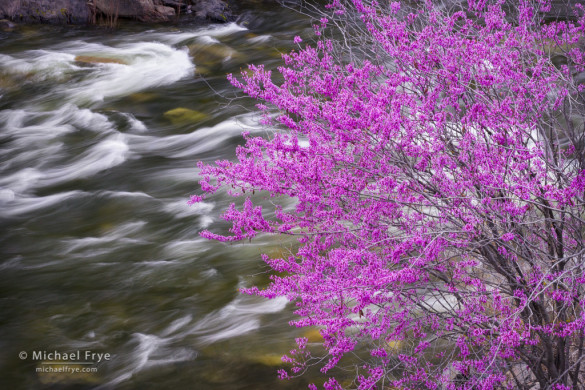
Redbud along the Merced River, Merced River Canyon, March 2013
February has been exceptionally warm, so I probably shouldn’t be surprised to see signs of spring already. But redbuds? In February? Apparently so. Claudia drove up to Yosemite Valley on Saturday, and reported seeing redbuds and a few poppies blooming in the Merced River Canyon west of the park. It’s not unusual to see poppies in late February, but the redbuds are a month early. Claudia said that only a couple of them were in full bloom, but many more were starting.
Temperatures dropped significantly over the weekend, and I’m not sure how that will affect the redbuds, or the poppies. Under normal circumstances the redbuds would continue to progress, and reach peak in perhaps a week or so. But these aren’t normal circumstances, so all bets are off.
(more…)
by Michael Frye | Feb 22, 2015 | Yosemite Photo Conditions
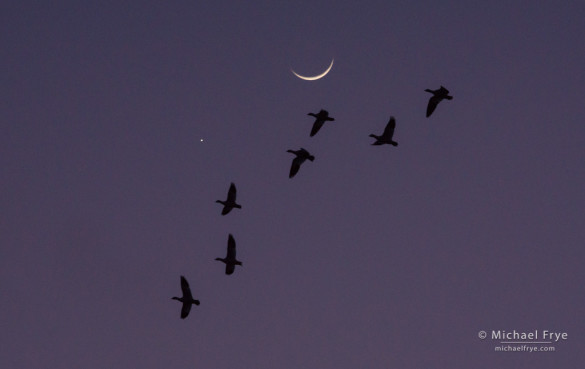
Moon, Venus, and Ross’s geese, San Joaquin Valley, CA, USA
I’ve been working on a book deadline, so haven’t been able to get to Yosemite Valley and check on Horsetail Fall recently. But I did break away from the desk on Friday to go down to the Central Valley and photograph birds. At first the light was rather uninspiring, because the fog I was hoping for had lifted into a low overcast. But it turned out to be a great day. I photographed one of the biggest goose takeoffs I’ve ever seen, with perhaps 30,000 birds lifting off at once; one of the photographs below shows part of that group. Later, the sun broke through the stratus deck to create some beautiful sunbeams, and at dusk Venus and the crescent moon appeared (above).
As for Horsetail, the flow diminished quickly after the last rainstorm, and from reports I’ve heard there is basically no water in it – just a bit of dampness. There is another storm predicted for today and tomorrow. This is expected to be both colder and weaker than the last storm, with snow levels around 6,000 feet, but limited moisture. Horsetail might get some help from this system, but probably not much. Even if this storm turns out to be bigger than predicted, any precipitation in Horsetail’s drainage will fall as snow, so there won’t be a significant boost in flow until the sun comes out and melts some of that snow. It’s supposed to be sunny Tuesday, Wednesday, and Thursday, so maybe by Wednesday or Thursday we could see a decent water flow in Horsetail.
(more…)
by Michael Frye | Feb 15, 2015 | Composition, Light and Weather
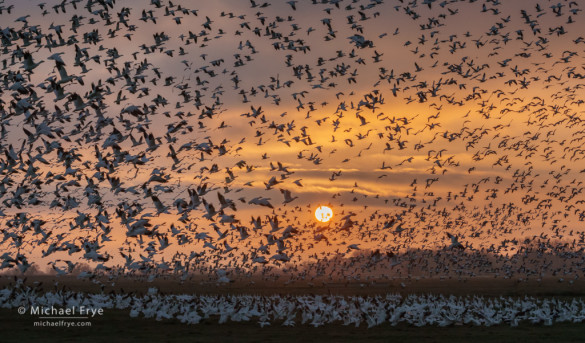
Ross’s geese taking flight at sunset, San Joaquin Valley, CA, USA
It should come as no surprise to any photographer that the interaction between subject and light is important. In fact, I’d say that this interaction is the essence of the whole thing; it’s what photography is all about.
But which comes first? Do you look for an interesting subject, and then find the right light for it? Or do you look at the light first, and then find a subject that fits the light?
I think both approaches can work. But having said that, I almost always think about light first. What’s the light now? What might happen to the light in the next five minutes, ten minutes, hour, or two hours? I try to anticipate how the light and weather might change, decide what kind of subject(s) could work with that light, and only then decide where to go.
(more…)
by Michael Frye | Feb 12, 2015 | Night Photography
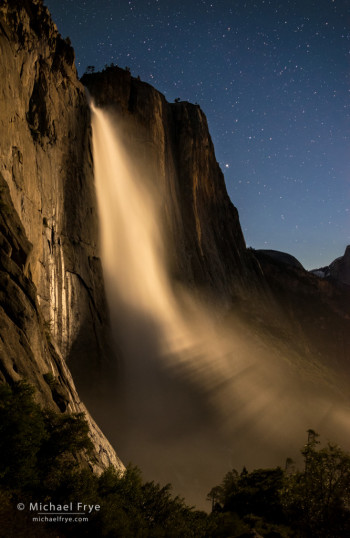
Upper Yosemite Fall illuminated by the rising moon, Monday night
After photographing Horsetail Fall on Monday evening I was thinking about heading home, but it occurred to me that this might be the perfect night to make a photograph I had been thinking of, with Upper Yosemite Fall backlit by the rising moon. The moon was due to rise about 11:00 p.m. Consulting PhotoPills, it seemed like the angle and phase of the moon were about right. And with the waterfalls so full, plus cloud-free skies, it seemed unlikely that I’d ever find better conditions.
So I decided to go for it. I had dinner at the Food Court at Yosemite Lodge, then connected to the Lodge wi-fi and answered emails for awhile. About 8:30 I headed up the trail.
Hiking the Upper Yosemite Falls Trail in the dark was a strange, surreal experience. I’d been up this trail at night before, but under a full moon. Prior to the moonrise Monday night it was very dark, with the only light coming from the stars. I had to use my headlamp to negotiate the rocky trail, and the bright light ruined my night vision. When I came around the bend where you typically get your first view of the upper fall, I could hear it, and feel the spray, but couldn’t see it at all. I had to turn off my headlamp and let my eyes adjust for a minute, and then I could just make out a tall, skinny triangle of less-than-pure-blackness ahead of me – the waterfall.
I didn’t get as wet as expected going past the base of the fall; I’ve been soaked at this spot before, but the water level apparently wasn’t as high this time. But the waterfall was loud. I arrived at my spot early, and had time to try out different compositions before the moon rose.
(more…)
by Michael Frye | Feb 10, 2015 | Yosemite Photo Conditions
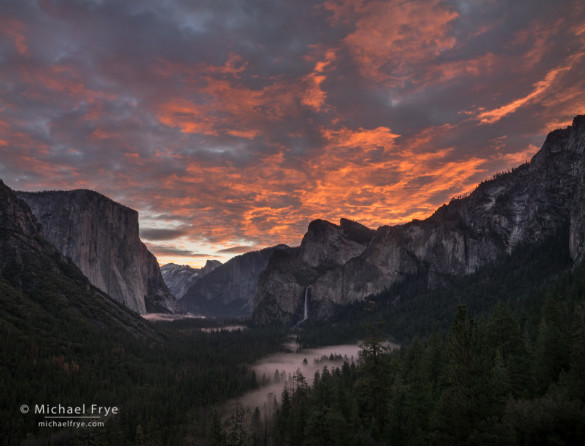
Sunrise from Tunnel View, Sunday morning
Yosemite Valley got about three inches of rain from the storms over the weekend. That’s not a drought-busting amount, but it helps, and I’m grateful for every drop.
The first wave of rain arrived Friday night, and lingered through Saturday. Early Sunday morning I looked at the satellite and radar images online, and saw thin, high clouds moving in ahead of the next system. Thinking that those clouds might light up at sunrise, I made the trip up to Tunnel View. Soon after I got there a bit of color appeared behind Half Dome, and then within minutes the whole sky caught on fire. It turned into the most colorful sunrise I’ve ever seen from that spot; you can see a photograph above.
The second wave of rain arrived Sunday evening. It started slowly, but around 9:30 p.m. a band of heavy rain passed through Mariposa County and headed toward Yosemite. I was actually out driving during this squall, and had to stop and pull off the road four separate times because it was raining so hard I could only see about 20 feet ahead.
(more…)
by Michael Frye | Feb 8, 2015 | Composition
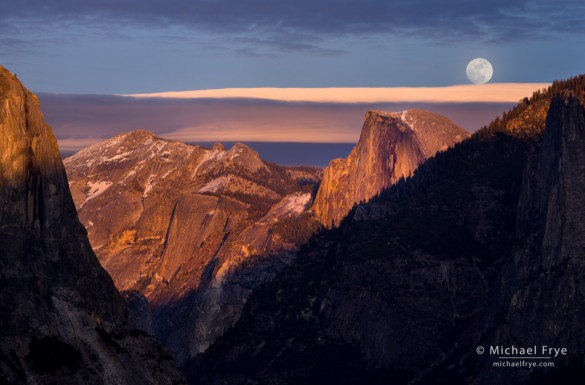
Moon rising above Half Dome from Tunnel View, Yosemite NP, CA, USA
During my workshop in Yosemite last week we photographed a spectacular moonrise on Monday evening from Tunnel View. A band of lenticular clouds hung in the sky in the distance, and just before the moon rose the sun broke through the clouds behind us and lit up El Capitan and Half Dome with vivid shades of orange.
In a recent interview I did for David Johnston and his Photography Roundtable podcast, we talked about using telephoto lenses for landscapes, and how using a longer lens is one way to simplify a composition. I use whatever lens seems appropriate for the situation – the lens that allows me to include all the essentials, but only the essentials. In the photograph above, that meant using my 70-200mm zoom at 183mm in order to fill the frame with the moon, Half Dome, that lenticular cloud, and the v-shaped notch below and to the left of Half Dome.
(more…)
by Michael Frye | Feb 6, 2015 | Yosemite Photo Conditions
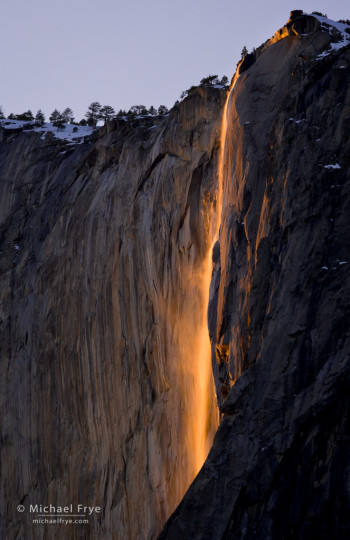
This photograph from 2009 shows what an average February flow in Horsetail Fall looks like
After a wet spell in December, the rain spigot got turned off. Yosemite Valley received seven one-hundredths of an inch of rain for the entire month of January. San Francisco set a record for January that can never be broken, with no measurable precipitation.
Not surprisingly, there isn’t much water in Horsetail Fall. In fact there’s no detectable flow at all – just a little dampness near the top. But forecasters are predicting a significant storm this weekend. They’re actually expecting two pulses, one tonight, and another on Sunday night. Total rainfall for the weekend could exceed four inches if the forecasts are right.
Horsetail should get a short-term boost from this storm. Whether that boost lasts longer depends on the exact snow level. Horsetail is fed by melting snow from a small drainage on top of El Capitan lying between 6,200 and 7,600 feet. The predictions for this storm put the snow level at 8,000 feet. If the actual snow levels are a little lower, and Horsetail’s tiny watershed gets some significant snow, then the runoff from that snow melting could last for a couple of weeks and provide at least some flow during the prime photography period later this month. If the snow levels are higher, and Horsetail’s drainage gets only rain, the water will run off quickly and won’t provide a lasting increase in the flow.
(more…)
by Michael Frye | Jan 29, 2015 | Photography Tips
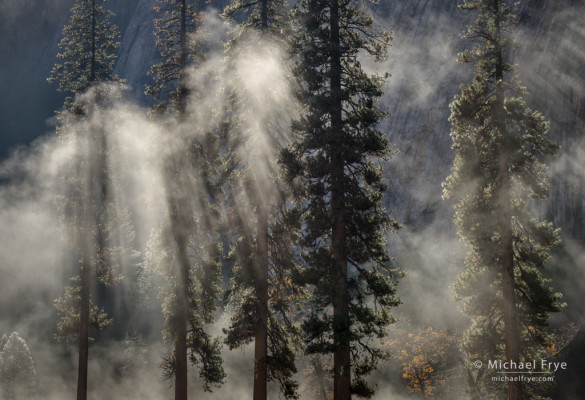
Ponderosa pines in mist, El Capitan Meadow, Yosemite
Natural light comes in an infinite variety of beautiful flavors. I love them all, but if I had to pick a favorite, it would probably be backlight, because it consistently delivers some of the most interesting images. All of the photographs from my last two posts, the ones from above the fog layer, were made with the camera pointing toward the sun. The photograph above, one I haven’t posted here before, captures a moment when backlit mist rose into the pines in Yosemite’s El Capitan Meadow. This next image, voted my top photograph of 2014, was also lit from behind, with the sun just above the frame:
(more…)
by Michael Frye | Jan 26, 2015 | Vision and Creativity
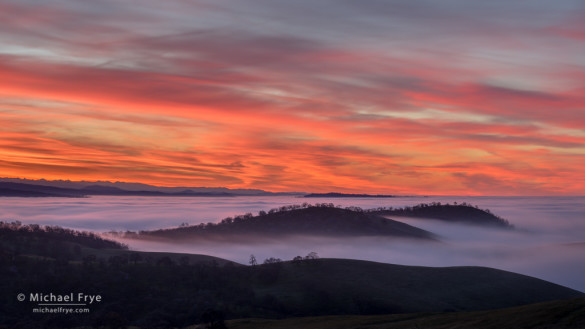
Sunrise above a fog layer, Sierra Nevada foothills, Thursday morning; focal length was 75mm
As I mentioned in my last post, the fog display on Thursday morning might have been even better than Wednesday morning. It didn’t look very promising at first. There was no fog at our house, and none in Mariposa either, so I knew I had to go lower. Claudia was with me this time, and we decided to take a back road that headed west into the lower foothills. At one point we crested a ridge, and there, below us, was the sea of fog.
Again I was fortunate to find a good viewpoint looking toward the southeast. This time there was a layer of high clouds above the fog, already starting to turn color with the sunrise. Best of all, a double-peaked hill was poking up out of the fog in that direction. The image at the top of this post is an early one from that morning, with a brilliant sunrise above the fog and hills.
After the sun rose, the fog lifted into some nearby ridges, getting high enough to almost – but not quite – obscure that double-peaked hill. Soft backlight filtered through the high clouds, bringing out beautiful textures in the fog (see the two images below).
(more…)
by Michael Frye | Jan 25, 2015 | Light and Weather, Vision and Creativity
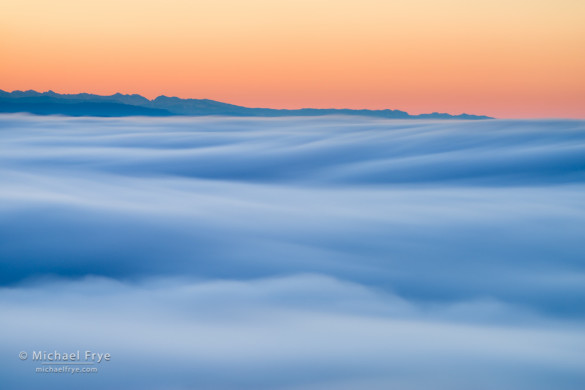
Fog and southern Sierra peaks from Mt. Bullion at sunrise, Mariposa County, Wednesday morning
After the episode of dense fog in the Central Valley that I mentioned in my last post, the fog lifted into what meteorologists call a stratus deck last week – essentially a layer of fog that’s slightly above ground level. From the Central Valley the stratus deck would look like a low overcast. If you were to drive out of the valley into the Sierra, you’d climb into the clouds, and into a layer of fog, and then eventually get above the fog and into sunshine. And if you could find a hill or ridge that rose above the stratus deck, you’d be able to look out over a sea of fog.
That sight should be familiar to people who live in the San Francisco Bay Area, or anywhere along the California Coast. When I lived in the Bay Area in the early ’80s, I remember driving along Skyline Drive on the Peninsula and looking out to the west over a sea of fog covering the ocean. At that time my interest in photography was in its infancy, but it was a beautiful sight. I’ve had that mental image in my mind ever since, and have long wanted to make photographs from above a sea of fog.
(more…)


















